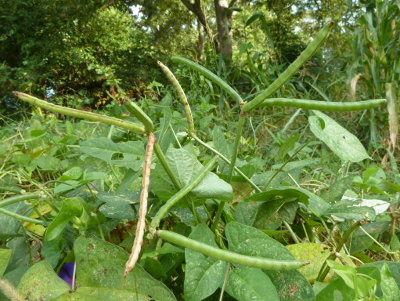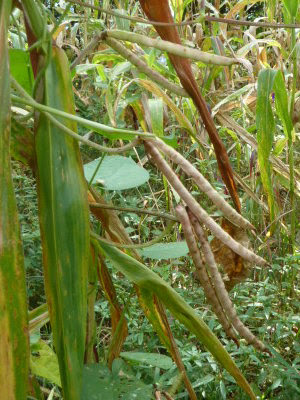

| Visitors Now: | |
| Total Visits: | |
| Total Stories: |
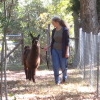
| Story Views | |
| Now: | |
| Last Hour: | |
| Last 24 Hours: | |
| Total: | |
Pea Pickin’
Cowpea pickin’ that is. This summer I planted cowpeas (aka Southern peas) in one third of our half acre grain field.
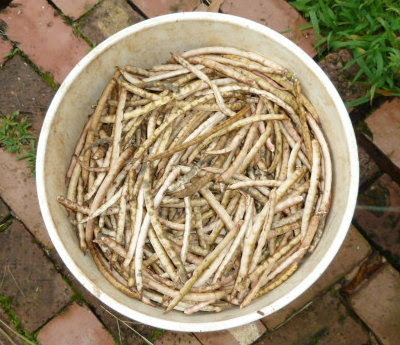 |
| 5 gallon bucket not quite full of cowpeas |
About a month ago, 5 rows almost filled a 5-gallon bucket like you see above. Several days ago, it only took 3 rows to do the same. I’ve got a total 18 rows and all the plants are loaded with pods in various stages not to mention load of blooms.
The variety is Ozark Razorback. It is a small cowpea that I plan to use in feed mixes for the goats and chickens. We haven’t tried them yet, but we can eat them too. I got a seed packet from Baker Creek Heirloom Seeds and planted it last year as a seed crop. I saved all that seed for a field planting this year.
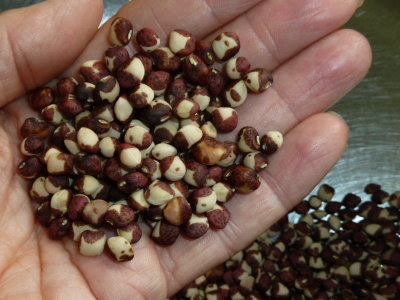 |
| Ozark Razorback cowpeas |
Cowpeas are said to be about 23% crude protein. Not as high as soy, but certainly easier to process and without the phytohormones. The protein content is important to me because one of my goals is to raise all our own animal feeds. This is still in the experiment and learn stage, and this is the first time I’ve grown more than a garden bed of cowpeas.
In regards to protein, I have noticed a huge discrepancy in what the charts say, and what the feed bag labels say. I’ve been feeding my goats a mix of wheat, oats, black oil sunflower seeds, and alfalfa pellets, barley when I can get it (which is rare). I buy these in 50 pound sacks and mix them myself. All the charts say wheat and oats are around 12% crude protein (CP). My feed bags say minimum CP is around 8%. That’s a pretty big difference. Are the feed companies merely covering their bases by giving a minimum guarantee? Or is that a fairly accurate assessment of the protein these grains actually contain? I do know that the nutrient content of our foods has been decreasing over the years, because of the way modern conventional farming handles the soil.
Many cooperative extension services offer feed and forage testing. Mine does, so using the Pearson Square, I calculated a mix of feed store wheat and oats, and those homegrown cowpeas. My target was 16% crude protein, the recommended CP for dairy goats. That came to roughly equal portions of each. I mixed a small sample and sent it off.
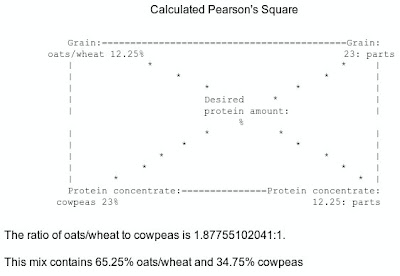 |
| I used the free online Pearson Square calculator, here Open image in its own window to enlarge |
As an aside, I confess I’ve questioned why the recommended crude protein for goats is higher than what they can naturally forage. Then I read in
It’s not what I aimed for but I am not displeased with this; I think it says something good about my cowpeas, even though our soil is nitrogen deficient. While this is not the recommended 16% for does in milk, it’s closer for a home mix than I had before. The results don’t explain to me what the second column means, 16.7% at 100 percent dry-matter. Nor do I know the exact CP content of the individual ingredients. That will be something I’ll have to have tested eventually. The results do tell me that the cowpeas can help provide what is needed. The test was inexpensive ($6) and will be an excellent tool for not only making sure I’m feeding what my animals need, but also making sure my soil fertility is good. Fortunately, these peas are fairly easy to pick, because the pods shoot up on stalks above the leaves. They will keep producing until frost kills them. The few plants nearest the corn, managed to climb a few corn stalks. That made them even easier to pick. I originally thought these were half-runners, but they did spread more than I remembered in the garden. Next year I’ll try planting them in with the corn. Two questions remain. Firstly, how much will I need to grow to have a year’s worth? I’ll have to wait and see how long this year’s crop lasts to answer that. The second question is how to best shell them all.
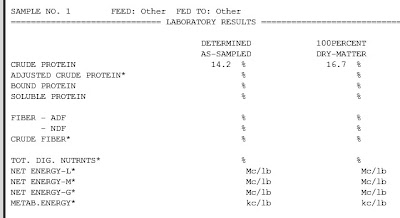
Right click and open in it’s own window to enlarge
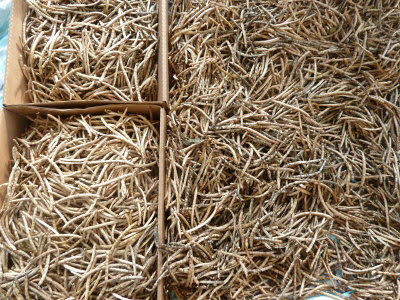 |
| Only the beginning…. |
Last year I did it by hand, this year I have too many. I’ve looked into shellers and can either opt for a small hand, “Mr. Pea” sheller for around $40, or a larger electric model. The smallest of these runs just under $300 ($400 if purchased from the manufacturer). I also found a homemade pea sheller at Mother Earth News. One pod at a time though. Seems easier just to do it the regular by-hand way.
I ordered a little “Mr. Pea” sheller, which can be hooked up to a small hand mixer as well as operated by hand. That might be worth a try first. Like all equipment, the question is, is it worth it in the long run. I don’t mind hand shelling dried beans or peas for supper. Shelling hundreds of pounds to feed our animals? On the other hand, how much do I want to spend for a tool I’ll only use once a year? Right now my pocketbook dictates what I get. After this year I’ll have a better idea of whether or not it’s the best choice.
Related Posts:
Food Self-Sufficiency & Animals
More Thoughts On Growing Animal Feeds
2012-11-27 10:26:03
Source: http://www.5acresandadream.com/2012/09/pea-pickin.html
Source:



